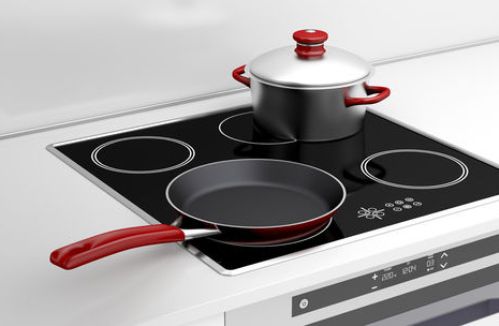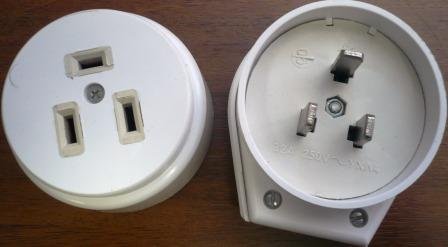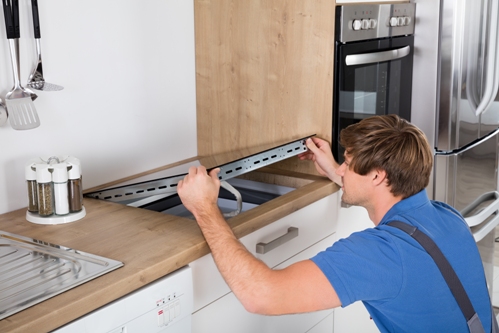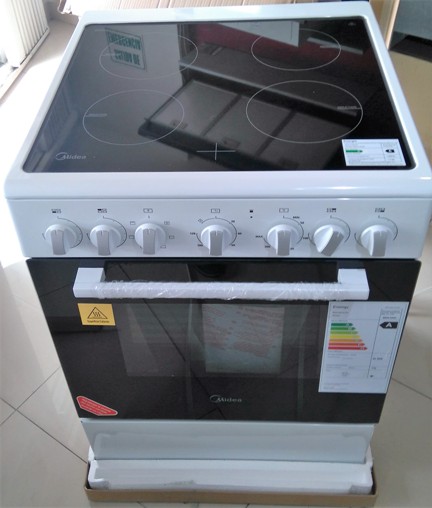Categories: Electrical connection of equipment, Electric installation work
Number of views: 61143
Comments on the article: 0
How to connect an induction cooker - useful tips
When purchasing a new induction cooker, do not rush to plug it into one of the free outlets. In this case, first of all, it is necessary to determine the possibility of connecting this household appliance to a particular section of the wiring and choose the most optimal way to connect it. Consider the question of how to connect an induction cooker.
It should be noted that before acquiring an induction cooker, it is necessary to clarify what load limit is defined for the apartment (house) and assess the possibility of operating a particular induction cooker taking into account its maximum power consumption.

Connecting a desktop induction cooker
A desktop induction electric stove, as a rule, has a cord and a plug for connecting to a regular household outlet. That is, in this case there is no need to purchase an additional cord and plug for connecting the appliance. But in this case, it is very important to choose the right outlet to turn on the electric stove.
Very often they make a mistake - they turn on the electric stove in one of the free sockets, without taking into account its load capacity, that is, the amount of load that can be included in this socket.
In the best case, one of the circuit breakers in the electrical switchboard will trip - as a result of overload at one of the wiring sections. But in the absence of proper wiring protection, for example, if several wiring lines are connected to one circuit breaker, overload will damage the wiring.
Therefore, before you start operating the electric stove, you need to find out its maximum power consumption and make sure that this appliance can be plugged into one of the available outlets. Power consumption is indicated in watts (W) or in kilowatts (kW) in the passport on the electric stove body, as well as in the technical specifications in the operating instructions of this household appliance.
It should be remembered that a conventional household power outlet is designed to turn on household appliances with a rated power of not more than 3.5 kW, which corresponds to a load current of 16 A. That is, if the power consumption of an electric stove does not exceed this value, then it can be included in this outlet.

Next, you need to make sure that the wiring section supplying this outlet is able to withstand the load of the induction cooker. How to find out?
First, you need to clarify which cable is connected to the outlet, and how it connects to the rest of the home wiring. The cable supplying the outlet must have a cross section of at least 2.5 square meters. mm
If the cable is connected directly to the home distribution panel, then such a wiring line can withstand the current of a household outlet; to protect such a wiring line, you can install a circuit breaker of the required rating. This option is most preferred in terms of reliability.
The second common option is the cable that feeds the outlet, is connected in a junction box. In this case, it is necessary to take into account the loads of other outlets connected to this junction box.
The cable that goes from the main switchboard to the junction box must withstand the total load of the outlets powered from it.Therefore, if the load of the induction cooker is an overload for a given section of the wiring, then to turn it on, select another outlet with the corresponding load capacity.
Secondly, it is necessary to assess the technical condition of the wiring. If the wiring is in an unsatisfactory technical condition, then, accordingly, when a new load is switched on, it may be damaged (see - How to audit the electrical wiring in the apartment) In this case, it is necessary to pay attention to the condition of the cable, in particular its insulation.
A cable with copper conductors is preferable, but if an old aluminum wiring is installed in the house, then it is highly likely that such a cable does not withstand the permissible load.
It is also necessary to pay attention to the state of the contact connections of the wiring at the point of cable connection in the home switchboard, outlet, as well as intermediate contact connections in the junction box.
For inclusion in a network of an induction cooker do not use extension cords or tees. For safe operation of the induction cooker, it must be grounded, that is, plugged into a power outlet with a working ground.
It is also necessary to pay attention to the status of the outlet. If the plug of the appliance is not in good contact with the sockets of the outlet, then such an outlet must be replaced.

Induction hob connection
The induction hob has a large power, it is not plugged into an ordinary household outlet, but into a power outlet rated for a current of more than 16 A.
The power outlet for connecting the induction cooker is selected according to its load. The total load of the induction cooker can be an average of 25-32 A, depending on the number and power of the burners.
In this case, an individual wiring line must be laid to power the induction cooker. The cable cross section depends on the load of the induction cooker: for a current of 25 A, a copper cable with a cross section of 4 square meters should be laid. mm, for a load of 32 A - 6 square meters. mm

For safe operation of the induction cooker, the wiring must have a working protective earth. That is, for a single-phase network, a three-core cable must be connected to connect the induction cooker. Accordingly, the purchased power outlet kit with plug must also have a third ground contact.
If it is not possible to purchase a power outlet of the required power, then as an alternative, you can connect an induction hob to terminal blockinstalled in the mounting box. The terminal block must withstand the rated current of the induction cooker connected to it.
As for the cable through which the induction cooker is connected, in this case it all depends on the configuration. If the power cable is included, it is enough to connect it to the terminal block directly on the induction cooker, and then to the purchased power plug or in the terminal block, depending on the chosen method of connecting the induction cooker.
If the cable is not included, then it must be purchased separately. When purchasing a cable, it is necessary to pay attention to its cross-section - it must correspond to the connected load. You must purchase a flexible three-core cable with a cross section of 4 or 6 square meters. mm for rated currents of 25 and 32 A, respectively.
In order to avoid errors, it is recommended to connect the cable to the plate itself, as well as to the plug common color coding: brown or black - phase conductor, blue - neutral conductor, yellow-green - protective earth conductor.
If the cable is already connected to the terminal block of the electric stove, it is necessary to check the correctness of its connection. The following terminal markings are usually indicated on the terminals of the induction cooker:
-
L - phase output or L1, L2 (L3) - phase outputs with two-phase (three-phase) inclusion;
-
N is the zero output;
-
PE is the connection point of the protective earth conductor.

Two-phase and three-phase induction cooker connection
Certain types of induction hobs may include a two or three phase electrical connection. If the house is made three phase input, then such an electric stove is connected, as the manufacturer recommends, to two or three phases of electrical wiring with a four or five-core cable.
The electric stove is connected to a single-phase household electrical network by a three-core cable, and special jumpers between the phases, which are usually supplied, are installed in the terminal block on the induction cooker. If there are no jumpers, then connection to two or three phase terminals is carried out by a wire corresponding to the load of the cross-section electric stove.
It should be noted that if a cable for two- or three-phase connection is included in the kit, it is not designed for single-phase switching, since with a single-phase connection of the induction cooker, the load on the phase conductor increases to the total load of all phases.
Therefore, when four (five) core cable is used for connecting to a single-phase network, two (three) phases on the plate are connected to the cable conductors, and at the other end of the cable, when connected to the plug or in the terminal block, the phase conductors are shorted together and connected to the same phase of the mains . Or a new three-core cable is purchased that has sufficient load capacity for a single-phase connection of an electric stove.

Connection of induction cooker with oven
The process of connecting an induction cooker with an oven is no different from connecting one induction hob. The only difference is the high power consumption, as in addition to the induction hob, the power of the oven is added. Accordingly, it is necessary to choose the right section of the cable, as well as the set of power outlet and plug for connecting the furnace to the network.
There are types of induction cookers with an oven, which provide for limiting the maximum power consumption by turning off one of the burners during operation of the oven. That is, it is possible to operate simultaneously all the rings of the induction cooker, but when the oven is turned on, the possibility of turning on one burner is blocked. This option is most suitable for houses with a limited power limit, which does not allow the operation of sufficiently powerful electric stoves.
Protective devices
When connecting an induction cooker, it is very important to choose the right protective devices. To protect the induction cooker, as well as the power supply wiring, a circuit breaker is installed. The rated current of the circuit breaker is selected based on the power of the induction cooker. In this case, the nearest higher current value is selected, but the characteristics of the wiring are also taken into account - circuit breaker must protect all wiring components.

To ensure the safe operation of the induction cooker, a distribution panel is installed residual current device (RCD), which protects against electric shock, as well as fire in case of leakage of current through damaged insulation. The RCD should be rated for the rated current, taking into account the possible load on the wiring line.
For example, if a circuit breaker of 32 A is installed on the line, then the RCD must be designed to operate at a higher rated current of 40 A, since the thermal release of the circuit breaker, when the current exceeds 32 A, does not turn off immediately, but with a certain delay.To protect a person from the negative effects of electric current, the differential response current of the residual current device must be no more than 10 mA.
Alternatively, you can use a combined device - differential automatonperforming the functions of the two above protective devices.
See also on this topic:How to lay the cable from the shield to the outlet when connecting the electric stove
See also at bgv.electricianexp.com
:
